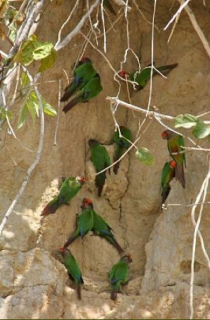Rose-fronted Conure |
|
|
Also known as: Rose-fronted Parakeet, Red-crowned Conure or Parakeet
Photos
View in GalleryDid You Know?
The Rose-fronted Conure is one of only two Pyrrhura conures to have bright rose/red on its crown, the other being the Rose-crowned Conure (P. rhodocephala).Academic Research
Related publications: Pyrrhura roseifronsSpecies Profile
Genus: Pyrrhura | Species: roseifrons
Size:
22cm (8.6 in)
Weight:
54-70g (1.9-2.5 oz)
Subspecies including nominate:
one
Colour Adult:
Both adults partly green; rose/red forehead and face; maroon/brown lower cheeks; pale yellow ear coverts; dull green/brown breast scalloped with green/yellow; red bend of wing and carpal edge; brown/maroon patch on abdomen; brown/red tail becoming green at base. Bill dark grey. Eye ring bare and cream/white. Eye brown.
Colour Juvenile:
Dark maroon/brown forehead and face; buff/white ear coverts; grey/green upper breast scalloped with yellow/green; green lower breast; green bend of wing and carpal edge; brown/red patch on abdomen less evident; shorter tail.
Call:
Calls made in flight are coarse and forceful staccato notes.
Listen NowVideo Links:
Video 1 | Video 2More Information:
Content Sources:
BirdLife International
Cornell Lab of Ornithology/Birds of the World
A Guide to Parrots of the World, Juniper and Parr, 1998
ML Media Collection Catalogue 140459, Rose-fronted Parakeet Pyrrhura roseifrons, Harvey, Michael, Ucayali, Peru, Sep. 11 2008, Cornell Lab of Ornithology. Site
Parrots of the World, Forshaw, 2006. 2010 edition
Parrots in Aviculture, Low, 1992.
Lexicon of Parrots, Thomas Arndt.
Photos
View in GalleryDid You Know?
The Rose-fronted Conure is one of only two Pyrrhura conures to have bright rose/red on its crown, the other being the Rose-crowned Conure (P. rhodocephala).Academic Research
Related publications: Pyrrhura roseifronsSpecies Care
Captive Status:
Uncommon
Longevity:
Probably 13-15 yrs.
Housing:
As for P. picta: aviary or suspended enclosure, minimum length 2m (6.5 ft).
Diet:
As in P. picta: Fruits such as: apple, pear, oranges, bananas, cactus fruits, pomegranate, kiwi, papaya, forming about 30 percent of the diet; vegetables such as: carrot, celery, green beans and peas in the pod; fresh corn; green leaves such as: Swiss chard, lettuce, sowthistle, kale, dandelion, chickweed; spray millet; small seed mix such as: canary, millet and smaller amounts of oats, buckwheat, safflower and a little hemp; soaked or sprouted sunflower seed; cooked beans and pulses, boiled maize and complete kibble.
Enrichment:
Vigorous chewers so provide bird-safe, unsprayed flowering, fir, pine, willow or elder branches; wooden block or vegetable tanned leather chew toys, heat sterilized pine cones. Also provide overhead misters or shallow bowls of water for bathing.
Nest Box Size:
As for P. picta: vertical box 8" x 8" x 28" (20.3cm x 20.3cm x 71.1cm).
Clutch Size:
Probably 5-7.
Incubation Time:
About 23 days.
Fledging Age:
About 40-51 days.
Hatch Weight:
Probably 3-4g (0.1-0.14 oz).
Peak Weight:
Not recorded.
Weaning Weight:
Not recorded.
Photos
View in GalleryDid You Know?
The Rose-fronted Conure is one of only two Pyrrhura conures to have bright rose/red on its crown, the other being the Rose-crowned Conure (P. rhodocephala).Academic Research
Related publications: Pyrrhura roseifronsSpecies Wild Status
World Population:
Unknown, decreasing.
IUCN Red List Status:
Least Concern
CITES Listing:
Appendix II, as congener of P. picta.
Threat Summary:
This species is at threat from trapping for the wild bird trade, hunting and habitat loss. Is suspected to lose 7% of its suitable habitat over three generations (18 years) and given the species’ potential susceptibility to hunting and/or trapping, there is concern it could decline by < 25% over three generations.
Range:
W Amazonia from N Brazil and NE Peru south to N Bolivia.
Habitat:
Found up to 1200m (3936 ft) in humid forest in foothills and in lowland terra firme and varzea forests; also in margins and adjacent clearings with tall trees. Seen in stunted forest along riverways with large bamboo patches.
Wild Diet:
Probably fruits, berries, seeds, buds, shoots and insects and their larvae.
Ecology and Behaviour:
Seen in groups of up to 15 birds; inconspicuous while feeding or resting. Otherwise noisy and active in flight through or above forest canopy.
Clutch and Egg Size:
Probably 5-7 eggs, 25.5 x 19.0mm (1 x 0.7 in).
Breeding Season:
Probably July-December. Nest is in tree cavity.
Related Links:
Peru Aves
Research: Considerations on the type specimens and type locality of Pyrrhura roseifons
Photos
View in GalleryDid You Know?
The Rose-fronted Conure is one of only two Pyrrhura conures to have bright rose/red on its crown, the other being the Rose-crowned Conure (P. rhodocephala).Academic Research
Related publications: Pyrrhura roseifronsMembers Only Resources
Please log-in now to find more research, resources and tools.
Not a Member?
Find more great information:
Gain exclusive access to 600+ pages of additional research, seminars and podcasts, specialists to ask your toughest questions, and dozens of other fun resources - when you become a WPT member.
Join Today >>

































